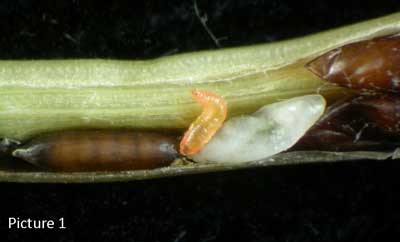
- Hessian fly is one of the most destructive pests of wheat.
- Two generations per year are reported in the Midwest.
- The larvae feed on small seedlings causing severe damage and even plant death in the fall.
- Spring feeding by the larvae can result in plant lodging and yield losses.
- Wheat planting after the fly free period and the use of insecticide seed treatments can reduce Hessian fly damage.
Identification and Life Cycle
The Hessian fly, Mayetiola destructor (Say), is one of the most important and destructive pests of wheat. It is also a pest of barley and rye but wheat is its preferred host. It overwinters as a full grown larva (maggot) inside cases that resemble flax seeds (Pic. 1). Once wheat comes out of dormancy in the spring, Hessian fly adults emerge and mate. The adults are mosquito-like in appearance (Pic. 2) less than 1/8" long. A female lives for about 4 days but during this time is able to lay 250-300 eggs. The eggs are small and reddish in color and are laid in groups of 2-15 eggs in grooves on the upper leaf surface. Eggs hatch within 3-10 days into a legless maggot initially reddish in color before turning white (Pic. 1). Once they begin feeding, the maggots become stationary and may reach their maximum size in a couple of weeks. Then their outer skin gets loose and hardens into a protective flax seed case. They remain inside that case through the summer and emerge as adults in early fall. Two generations per year are reported in the Midwest.
Damage
It is the immature, maggot stage that causes damage to wheat. They feed on the lower part of the stem by rasping the tissue and sucking the sap oozing from the wound. Maggots never enter the stem but infested stems can break potentially causing yield losses (spring generation). In the fall maggots feed on small seedlings that may never grow past the four leaf stage. Infested wheat will appear stunted, dark green to bluish-green with thick leaves. Heavily damaged plants usually die during the winter.
Scouting
It is recommended to scout wheat at two stages, seedling stage (fall) and when heads begin to fill (spring). Examine 20 stems in 5 areas of the field by looking closely at the basal part of the plant and pulling the leaf sheath away from the stem to locate the maggots or flaxseed (Pic. 3). Record the number of stems with Hessian fly maggots or exhibiting feeding damage. In the spring record the number of lodged stems out of 100 to determine the percentage of Hessian fly damage.

Management
Cultural Options:
- Fly free period: One of the most helpful tools in managing Hessian fly is planting wheat after the fly free period (Pic. 4). This is a very widely adopted practice in the Midwest that has helped reduce damage to wheat in the fall. Wheat seedlings will emerge long after egg-laying by the adults leading to healthier, maggot-free plants and a more vigorous stand in the spring. Keep in mind that warm weather in late summer and early fall can extend Hessian fly activity beyond the average fly free date. Avoiding early planting can also aid in managing other pests like aphids and mites that tend to be more active under warmer temperatures.
- Fertility: Avoid overuse of nitrogen fertilization to prevent excessive vegetative growth thus reducing suitable feeding sites for Hessian fly.
- Sanitation: Destroy volunteer wheat and when possible incorporate wheat residues deep enough to bury the puparia (flaxseed case) and reduce the number of adults emerging from the ground.
- Crop rotation: Rotating wheat fields with non-host crops can be an effective management tool for reducing Hessian fly infestations.
Host Resistance: the use of resistant wheat varieties will result in poor survival of the Hessian fly larvae and can stop them from feeding inside the plant. Unfortunately Hessian fly eventually overcomes the defenses provided by resistant varieties by evolving into new biotypes.
Insecticide Seed Treatments: Neonicotinoid insecticides such as clothianidin, imidacloprid and thiamethoxam applied to the seed at planting will reduce fall infestations of Hessian flies and other early pests like aphids. These at plant applications however, will not control pest infestations in the spring.
Contact your FS Crop Specialist for your agronomic information.


Picture 1. Young (reddish) and full grown (white) Hessian fly larvae with flaxseed like puparia. (Source: GROWMARK, Inc.)
Picture 2. Hessian fly adult. (Source: John Obermeyer, Purdue University)
Picture 3. Sampling of Hessian fly. (Source: GROWMARK, Inc.)
Picture 4. Average Hessian fly free dates in the Midwestern states.